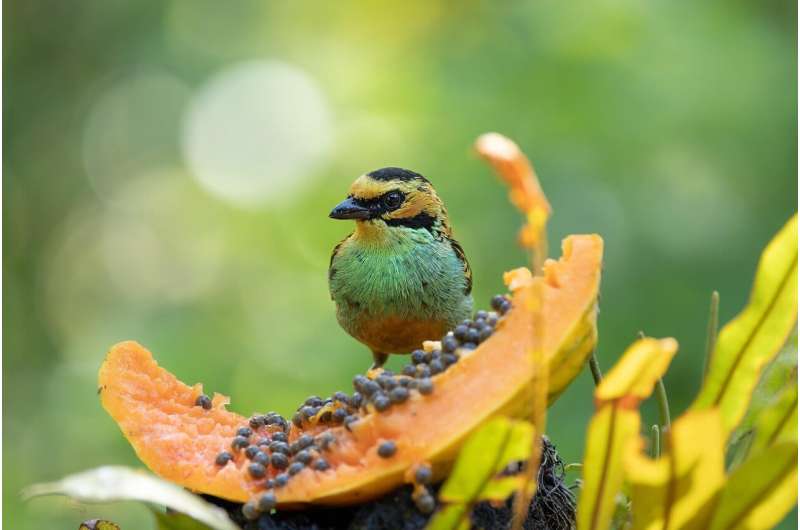Science
Researchers Uncover How Black and White Feathers Boost Bird Colors

Research from a team at Princeton University has unveiled a fascinating mechanism that allows birds to enhance their plumage colors using underlying black and white feathers. Published on July 26, 2025, in the journal Science Advances, this study sheds light on how these seemingly dull feathers play a crucial role in making vibrant colors more vivid.
Rosalyn Price-Waldman and her colleagues found that colored feathers appear brighter when situated over a layer of black or white feathers. This discovery suggests that the color differences between male and female birds are not solely due to the pigments in their feathers but also depend significantly on the color of the feathers beneath them.
Unraveling the Colorful World of Birds
Birds are renowned for their vibrant colors, yet species with exclusively black and white plumage, such as magpies, are comparatively rare. The study highlights that vibrant colors, particularly in male birds, have evolved through a process known as sexual selection. As noted by Charles Darwin, males with more vivid colors are often more successful in attracting mates, leading to a greater number of offspring.
In practical terms, the underlying black layer enhances the brilliance of blue feathers by absorbing light that passes through them. The blue color is a result of the fine structure of these feathers, which scatters light in a specific way. When the underlying layer is black, it prevents other wavelengths of light from reflecting back, allowing the blue to stand out more prominently.
Interestingly, the study also revealed that yellow feathers, which derive their color from carotenoid pigments, benefit from a contrasting white under-layer. The white layer reflects light, enhancing the brightness of yellow patches and making them more visually striking against other colors.
A Widespread Phenomenon in Various Bird Species
The research primarily focused on tanagers, colorful fruit-eating birds native to Central and South America. Following their findings in this species, the researchers expanded their investigation to include other bird families. They discovered that the use of black and white feather layers to enhance coloration is a widespread phenomenon among numerous species, including the vividly colored Australian fairy wrens.
This prevalent adaptation indicates that birds have been utilizing this clever strategy to enhance their plumage for tens of millions of years. The findings contribute valuable insights into the evolution of complex traits like color in nature. Furthermore, this research could inspire advancements in producing vibrant colors in architecture, art, and fashion.
The study, titled “Hidden white and black feather layers enhance plumage coloration in tanagers and other songbirds,” is authored by Rosalyn M. Price-Waldman and her team, and can be accessed through Science Advances (DOI: 10.1126/sciadv.adw5857). This significant research underscores the intricate ways in which natural selection and evolutionary processes shape the vibrant world of avian colors.
-

 Entertainment2 months ago
Entertainment2 months agoIconic 90s TV Show House Hits Market for £1.1 Million
-

 Lifestyle4 months ago
Lifestyle4 months agoMilk Bank Urges Mothers to Donate for Premature Babies’ Health
-

 Sports3 months ago
Sports3 months agoAlessia Russo Signs Long-Term Deal with Arsenal Ahead of WSL Season
-

 Lifestyle4 months ago
Lifestyle4 months agoShoppers Flock to Discounted Neck Pillow on Amazon for Travel Comfort
-

 Politics4 months ago
Politics4 months agoMuseums Body Critiques EHRC Proposals on Gender Facilities
-

 Business4 months ago
Business4 months agoTrump Visits Europe: Business, Politics, or Leisure?
-

 Lifestyle4 months ago
Lifestyle4 months agoJapanese Teen Sorato Shimizu Breaks U18 100m Record in 10 Seconds
-

 Politics4 months ago
Politics4 months agoCouple Shares Inspiring Love Story Defying Height Stereotypes
-

 World4 months ago
World4 months agoAnglian Water Raises Concerns Over Proposed AI Data Centre
-

 Sports4 months ago
Sports4 months agoBournemouth Dominates Everton with 3-0 Victory in Premier League Summer Series
-

 World4 months ago
World4 months agoWreckage of Missing Russian Passenger Plane Discovered in Flames
-

 Lifestyle4 months ago
Lifestyle4 months agoShoppers Rave About Roman’s £42 Midi Dress, Calling It ‘Elegant’









